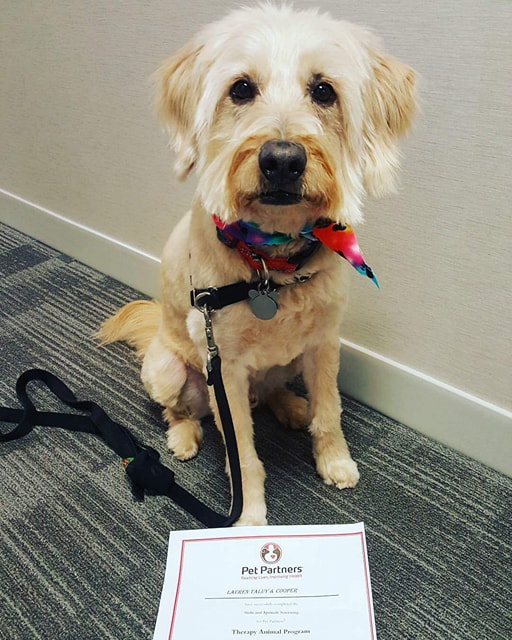Occupational therapist Lauren Taluy and her registered therapy dog Cooper are available to visit places supporting displaced families for Cooper to share some puppy love with those affected by the fires. Cooper is 10 years old and has been with Lauren since he was 8 weeks old, which is when he began his life as a therapy dog. Cooper’s family lives in Ventura and includes Lauren’s husband Timur and her 2 children, 4 year old Ellie and 2 year old Hudson. Please contact Lauren at 805-300-8103 or email [email protected] to arrange for a visit from Cooper.
Category Archives: The Pet Page
Vol. 11, No. 5 – Dec 6 – Dec 19, 2017 – The Pet Page
 • Purrs & Paws Holiday Boutique returns to Ojai for the Sixth annual Humane Society fundraiser slated for Dec. 16. Over 30 vendors will offer a vast variety of holiday gifts for people and pets, at the Humane Society of Ventura County’s holiday boutique.
• Purrs & Paws Holiday Boutique returns to Ojai for the Sixth annual Humane Society fundraiser slated for Dec. 16. Over 30 vendors will offer a vast variety of holiday gifts for people and pets, at the Humane Society of Ventura County’s holiday boutique.
The boutique will be open from 9 a.m. to 4 p.m. Saturday at the Chaparral Auditorium in Ojai, at 414 E. Ojai Ave. Newly added this year is a Vintage Market, on the lawn next to the auditorium.
All proceeds from this fundraiser will benefit the nonprofit HSVC.
With over 5,000 supporters, and marking its 85th year, the HSVC is committed to making this holiday market the best one yet. New and returning vendors will be featured.
Admission to this family-friendly event is free and open to the public.
For more information, contact Heather Rowe at [email protected] or 646-6505.
• The Teague Mansion in Santa Paula is the venue for Santa Paula Animal Rescue Center’s (SPARC’s) gala fundraising evening on December 8. The themed event is a 1930s murder mystery, featuring a theatrical production with plenty of intrigue. All proceeds from ticket sales and the silent auction will go toward medical costs and daily care of the animals at SPARC.
The evening includes a light buffet supper, beverages and a theatrical murder mystery filled with fun and drama. Tickets are $125 per person and can be purchased at http://bit.ly/2hF4KdC (Eventbrite link).
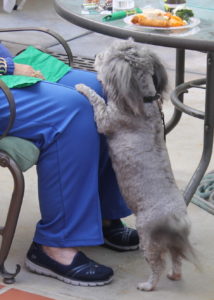
Many people are unaware that being a “no kill” shelter adds a high cost to running a shelter, since every animal, no matter how sick or injured, receives appropriate vet care. Every effort is made to give the animals a second chance at life at SPARC.
SPARC’s cost to run a “No Kill, No Excuses” shelter is $1.4 million per year; the city of Santa Paula contributes just over $100,000 of that. SPARC relies on grants and donations from the public.
Medical staffing and veterinary care alone is around $500,000, so it is vital to have the support of people who believe in the no-kill mission by buying their tickets to the 1930s murder mystery event and supporting other SPARC fundraising efforts.
• The FDA says it has received about 68 reports of pet illnesses, and even deaths, related to bone treats. Some of the reports involved more than one dog; a total of about 90 animals have been affected.
About 15 dogs have died of the illnesses, the agency said.
These treats differ from uncooked, butcher-type bones because they are processed and packaged for sale as dog treats. The products may be dried through a smoking process or by baking, and may contain other ingredients such as preservatives, seasonings or smoke flavorings.
Different types of bone treats for dogs, including treats described as “Ham Bones,” “Pork Femur Bones,” “Rib Bones,” and “Smokey Knuckle Bones,” were listed in the illness reports.
“Giving your dog a bone treat might lead to an unexpected trip to your veterinarian, a possible emergency surgery, or even death for your pet,” stated Carmela Stamper, a veterinarian in the Center for Veterinary Medicine at the FDA.
Vol. 10, No. 4 – Nov 22 – Dec 5, 2017 – The Pet Page
 • Sponsorship makes an ideal gift at any time of the year for an animal-loving friend or relative – birthdays, holidays, as a ‘thank you’ gift, or simply to say ‘I love you’! — either for a cat lover who has everything, or for friends and family members who love making a difference in the lives of animals. Your sponsorship gift of $25 or more, helps a cat or kitten awaiting adoption into a forever home. When you sponsor a cat or kitten as a gift, you will receive a certificate to the recipient and include both of you in the monthly Surfcat Mewsletter mailing. You can choose the message or dedication you want on the certificate.
• Sponsorship makes an ideal gift at any time of the year for an animal-loving friend or relative – birthdays, holidays, as a ‘thank you’ gift, or simply to say ‘I love you’! — either for a cat lover who has everything, or for friends and family members who love making a difference in the lives of animals. Your sponsorship gift of $25 or more, helps a cat or kitten awaiting adoption into a forever home. When you sponsor a cat or kitten as a gift, you will receive a certificate to the recipient and include both of you in the monthly Surfcat Mewsletter mailing. You can choose the message or dedication you want on the certificate.
Surfcat … Providing compassionate care and community connections for cats in need of forever homes. Surfcatcafe.org or 500-7125
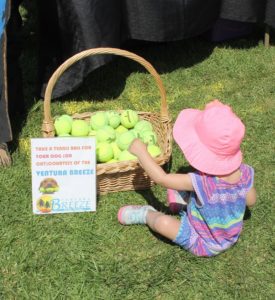
• In honor of America Recycles Day, the Canine Adoption and Rescue League (CARL)is accepting redeemable bottles and cans at their kennels located at 901 Mission Rock Road, Santa Paula. All proceeds from the recycling of plastic bottles and aluminum cans goes back to the kennel to help the dogs living in the sanctuary. CARL has been helping homeless dogs in Ventura County for the past 20 years. Alternatively, drop off the clean redeemable bottles and cans to the donation basket inside the back door of Pet Barn at 3203 E.Main.
• While the holidays can be the most wonderful time of year for people, it can be one of the most dangerous for pets.
Dr. Ryan Keane at Eastown Veterinary Clinic in Grand Rapids says pet owners should be aware of the health and safety hazards that are lurking in their homes during the holidays.
In addition to the obvious things an ingredient called Xylitol can be fatal, even in small doses.
In less than 24 hours, Xylitol can result in liver failure. The ingredient is becoming more popular in foods like peanut butter and sugar-free candies and gums.
When you decorate your tree, keep the tinsel off branches that are close to the ground, where your cat can easily grab them. “They have barbs on their tongue that point backwards so if they get a piece of string or tinsel on their tongue, they kind of have to swallow it. It can’t come back out,” Dr. Keane says.
We’re all guilty of sneaking a treat or two under the table, but keep in mind that a small portion for us can be a calorie overload for your animal. “Very small amounts are fine, the problem is when everybody wants to give that animal a small amount at family gatherings it’s all cumulative and adds up,” Dr. Keane says.
Dr. Keane suggests keeping an extra eye on your pet after you have company over and if they’re acting abnormally, it may be a sign they were exposed to something toxic. If you see this immediately get the pet to their vet.
• Experts have known for some time that dogs have poor vision, and are up to eight times worse than humans at seeing things in deta.
Scientists have developed a test for dogs and found that they struggle to tell red and green apart, much like color blind humans, a condition known as deuteranopia.
So they can hardly see a red ball on the green grass.
This is important for people directly involved in dog training but also for fols who want to improve their dog’s attentive skills during some activities such as play. If at the park and you want to get your dog to bring back a ball falling on the green grass it would be better if you thought of using blue instead of red toys.
• Dog owners have a lower risk of death from cardiovascular disease or other causes, a study of 3.4 million Swedes has found. The team analyzed national registries for people aged 40 to 80, and compared them to dog ownership registers.
They found there was a lower risk of cardiovascular disease in humans of dogs, particularly of hunting breeds. Researchers said it may be active people who choose to have dogs.
“The results showed that single dog owners had a 33% reduction in risk of death and 11% reduction in risk of heart attack,” compared to single non-owners, said lead study author Mwenya Mubanga of Uppsala University.
Dr Mubanga said: “Perhaps a dog may stand in as an important family member in the single households.”
For their study, published in Scientific Reports, the team looked at data from 2001 to 2012. In Sweden, every visit to a hospital is recorded in national databases – while dog ownership registration has been mandatory since 2001.
Owning a dog from breeds originally bred for hunting, such as terriers, retrievers and scent hounds, was associated with the lowest risk of cardiovascular disorder.
• Thirty-five dogs found inside robbery suspects home
By Victoria Usher
Inside the home of 72-year-old Robert Bustamante Flores, Corona bank robbery suspect, authorities discovered thirty-five dogs being kept in horrible conditions. They had been locked inside the home all day and all night, every single day. Animal Control officers were able to save the dogs, seven of them being small puppies and then took all of them to the Corona Animal Shelter so that they could be evaluated and fed.
Flores told detectives that twenty-six dogs were living inside his home when they asked him about the robbery. Once a search warrant was obtained four animal control officers and investigators searched the house together and found thirty-five dogs along with possible evidence of robbery. The good news is those dogs are now safe and have very recently become available for adoption! Hopefully they will all find their forever homes soon!
• A local Lancaster dog has won the 18th annual AKC Humane Fund Awards for Canine Excellence (ACE) in the Search and Rescue category! Each year the AKC® Humane Fund celebrates five loyal, hard-working dogs that have significantly improved the lives of their owners and communities. “Piglet,” a Lancaster Search & Rescue dog has brought closure to many grieving families.
“Piglet,” a six-year-old Catahoula Leopard Dog, is rigorously trained and certified to find human remains on land and in water. Each year Piglet and handler, Lori Wells spend hundreds of hours training, testing, and answering the call of duty for law enforcement agencies in California, Nevada, Arizona, and Utah. At nearly 7 years old, Piglet has built a reputation as an unparalleled search resource.
Piglet is unique not only for her diligent work ethic and talented nose, but also for her infectious ‘smile’. She always lights up the room at community events and fundraisers and is happy to make new friends, human and canine alike.
Vol. 10, No. 3 – Nov 8 – Nov 21, 2017 – The Pet Page
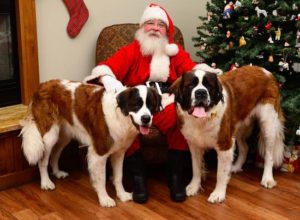
 The Humane Society of Ventura County’s annual Santa Paws holiday photo shoot is almost upon us. On Sunday, Nov. 19, the Ventura Beach Marriott will host the popular event, from 10 a.m. to 3 p.m. Two weeks later, on Sunday, Dec. 3, the HSVC Shelter will host a second Santa Paws pet photo shoot, also from 10 a.m. to 3 p.m. The shelter event will additionally feature a marketplace, where you can get some holiday shopping done while you wait, from the many local vendors who’ll be on hand selling quality goods. Plus, the shelter event will once again include its popular bake sale, where delicious handmade goodies will be available to purchase for your enjoyment. All proceeds from these events benefit the animals of the HSVC.
The Humane Society of Ventura County’s annual Santa Paws holiday photo shoot is almost upon us. On Sunday, Nov. 19, the Ventura Beach Marriott will host the popular event, from 10 a.m. to 3 p.m. Two weeks later, on Sunday, Dec. 3, the HSVC Shelter will host a second Santa Paws pet photo shoot, also from 10 a.m. to 3 p.m. The shelter event will additionally feature a marketplace, where you can get some holiday shopping done while you wait, from the many local vendors who’ll be on hand selling quality goods. Plus, the shelter event will once again include its popular bake sale, where delicious handmade goodies will be available to purchase for your enjoyment. All proceeds from these events benefit the animals of the HSVC.
Adults and children are welcome to pose in their pets’ photos – with or without Santa. The shelter will have many festive pet costumes to doll up your pets if you are in the mood. In addition to cats and dogs, pocket pets, reptiles, rabbits and birds are all welcome!
Holiday photo shoot packages start at $30 and include five to 10 images. For a larger donation, you also will have access to some wonderful HSVC keepsakes, including a 2018 HSVC calendar. All images will be provided on-site on USB flash drives.
For over 30 years, the Humane Society of Ventura County Santa Paws has been providing high-quality holiday family portraits for county residents and beyond. “Having helped with Santa Paws since 1990, I can tell you this is one very fun event – and it’s especially fun for us to see the families grow through the years,” said Greg Cooper, HSVC Director of Community Outreach and official photographer for the event.
• “Piglet,” a six-year-old Catahoula Leopard Dog, is rigorously trained and certified to find human remains on land and in water. Each year Piglet and handler, Lori Wells spend hundreds of hours training, testing, and answering the call of duty for law enforcement agencies in California, Nevada, Arizona, and Utah. At nearly 7 years old, Piglet has built a reputation as an unparalleled search resource. Read more about her in the next Ventura Breeze.
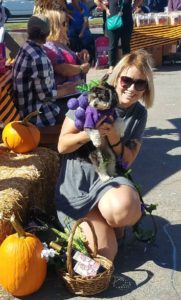 Four-footed “ghosts,” “spirits” and all manner of costumed canines paraded through Ventura Harbor Village on Saturday, October 21 as the 5th Annual Ventura Harbor Village HOWL-O-Ween Dog Costume Contest was held. Alyssa Clark and Tootsie, a 7 pound Chihuahua/Poodle/Yorkie mix were one of the winners. Tootsie is just over one year old and is dressed as a bundle of grapes with her own wine. Tootsie is too young to drink.
Four-footed “ghosts,” “spirits” and all manner of costumed canines paraded through Ventura Harbor Village on Saturday, October 21 as the 5th Annual Ventura Harbor Village HOWL-O-Ween Dog Costume Contest was held. Alyssa Clark and Tootsie, a 7 pound Chihuahua/Poodle/Yorkie mix were one of the winners. Tootsie is just over one year old and is dressed as a bundle of grapes with her own wine. Tootsie is too young to drink.
On October 28 the Pierpont Racquet Club held their 1st Annual Pooch Costume Parade. Dogs of all shapes and colors were entered as they paraded through the Club and were sure not to bark in order to not distract the players. Fun prizes and refreshments for pooches and their buddies were provided.
Vol. 10, No. 2 – Oct 25 – Nov 7, 2017 – The Pet Page
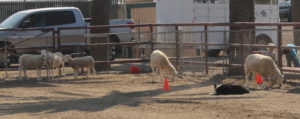
• The Herman Bennett Foundation is having their 4th Annual “Haunted Dinner, Magic, and Dancing” at the Bard Mansion October 28, from 6:00 pm – 10:00pm.
This fundraiser is to support these dog programs:
Help Military Dogs with their medical needs when they return from service
Ventura Police K-9 Unit (not paid for by the City)
Ventura County Animal Services (VCAS) Camarillo Shelter, a “No Kill” shelter
Vouchers for Low income families Spay/Neuter (cats & dogs) & Feral cats
Support of Animal Rescue Groups
This exclusive fundraising event has grown in both popularity and exposure over the past 3 years.
The event is held at the Historic Bard Mansion on the Port Hueneme Naval Base. It includes a formal sit down dinner, wine and beverages, Magician Bob Bolivar, Ghost Hunters Richard & Debbie Senate, live music by CosoLive, laughs provided by comedian Jason Love, a charity raffle and so much more!
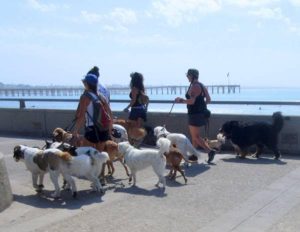
Tickets are $140 each, 6 or more tickets are only $100 each.
Call 445-7171 to reserve or visit our website:
Sponsorship opportunities may still be available! See website for details.
hermanbennettfoundation.org/events
• Many humans aren’t aware of the Halloween dangers to their loving pets. All that candy might be lethal for pet dogs and cats. They can’t metabolize candy like humans.
Chocolates contain caffeine and a compound called theobromine, which can be toxic in certain doses to both dogs and cats. Cats (poor things)can’t taste sweet so aren’t necessarily as drawn to chocolate as dogs. Theobromine is more concentrated in darker chocolates so that type is particularly bad.
Symptoms of eating chocolate are vomiting, diarrhea, trembling and hyperactivity.
Xylitol, a sugar substitute found in some sugarless gums and candies can cause hypoglycemia, seizures and even liver failure in dogs. Symptoms of xylitol poisoning can include vomiting, weakness and lack of coordination.
It important to keep candy secured in a location above the animal’s reach and make sure they aren’t there when you spread it out all over the floor.
Wrappers can also be a problem for pets, especially for cats that love to play with them
Many pet stores stock up on safe seasonal and Halloween treats so check them out.
• A tribute to Mom Cat by Cappi Patterson.
My precious little feral whom I fed for 10 years … she walked down the
block with me at night to her feeding place … meowing and holding her
tail straight up as she pranced along.
Mom Cat was killed by a hit and run driver.
Rest in Peace, Mom Cat. You were very loved.
• There have now been a total of 7 SDF (National Disaster Search Dog Foundation) trained Search Teams deployed to Mexico City for the earthquake that struck the region and another 5 SDF Teams in Puerto Rico to assist in the aftermath of Hurricane Maria.
The two- and four-legged rescuers that have deployed to help them are well-trained and prepared for whatever they may face. We wish them luck in their rescue operations and know that these teams will do all that they can to help those in need.
• Lung cancer is the biggest cause of cancer death in New Zealand largely because it is often detected late, but now Waikato University researchers believe dogs could be the key to saving lives (just another wonderful thing that dogs can do).
Dr Tim Edwards and his team are training pet dogs, including his own dog Tui, to sniff breath and saliva samples from the Waikato District Health board’s respiratory clinic.
“We will bring those breath and saliva samples into the lab and will have the dogs here evaluate those samples and see if they can tell us which ones are cancer positive and which ones are cancer negative,” stated Dr. Edwards.
Sensitive snouts are a well-known weapon in biosecurity, rescue operations and bomb detection.
And studies even suggest dogs may be able to sniff out even the lowest concentrations of aromatic compounds that come from tumors.
Here the focus will be on people with suspected lung cancer – one of New Zealand’s biggest killers.
“When the dogs sniff they are breaking an infrared beam and if they don’t like what’s in there, if it’s negative, they activate this switch which goes to the next sample, and if their nose stays in and breaks the beam for long enough it’s considered a positive sample and it’s treat time,” Dr Edwards said.
“The promise this technology brings is quick and cheap cancer detection solutions.”
Dr Edwards says one of the first things people ask him is what are the dogs smelling.
“They’re probably actually smelling a whole bouquet of compounds, and each dog’s definition is likely to be a bit different.”
He is using a range of pet dogs. “It’s not about the breed, as all dogs have ridiculously sensitive olfaction. It’s about their temperament and willingness to work,” he said.
Vol. 11, No.1 – Oct 11 – Oct 24, 2017 – The Pet Page
 • Scamp didn’t make it to this anniversary issue, but if he had we are sure this is what he would have said.
• Scamp didn’t make it to this anniversary issue, but if he had we are sure this is what he would have said.
I wrote for the Ventura Breeze for over nine years and enjoyed every minute of it. I was just a puppy when I started (about 30 years old in doggy years).
I want to thank my remarkable publisher-editor for giving me the opportunity to write for the Breeze after graduating from Furry State University in journalism. My mom wanted me to be a K9, but I felt that I was too small for the job.
Thanks to my great readers, Scampclub members, and Savana for leaving me alone while I was working at the computer. And for those of you that voted for me as President. Don’t you wish that I had won? And especially the advertisers that supported my page and continue to do so.
I am proud to have presented so many animals for adoption and for the many that were adopted.
My Scampclub members included dogs, cats, birds, a pig and even an elephant.
Doggy heaven is real nice. They feed us whatever we want, take us on long walks, and there are a lot of cute female French poodles for me to sniff. Fire hydrants are all over the place but I don’t use them.
I hope that you still enjoy reading the Pet Page but probably miss my funny little comments.
I miss you all and hope that you are doing well and am glad that the Pet Page continues in my memory.
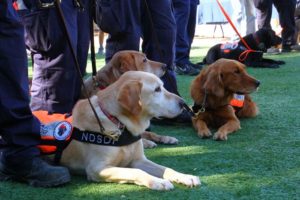 • The National Disaster Search Dog Foundation (SDF) opened the nation’s very first facility designed specifically for disaster search dogs and their handlers on September 23, 2017. Using 21 years of collective deployment experience gathered from canine disaster search teams and experts across the country, the National Training Center now gives former shelter dogs a place to call home while they transform into search dogs. It also provides search teams with experience in deployment simulations before they ever set foot at the site of a disaster.
• The National Disaster Search Dog Foundation (SDF) opened the nation’s very first facility designed specifically for disaster search dogs and their handlers on September 23, 2017. Using 21 years of collective deployment experience gathered from canine disaster search teams and experts across the country, the National Training Center now gives former shelter dogs a place to call home while they transform into search dogs. It also provides search teams with experience in deployment simulations before they ever set foot at the site of a disaster.
Located in the foothills of Santa Paula (it seems like Ventura), the National Training Center provides unique training props, including: a large rubble pile that simulates debris similar to the World Trade Center; Search City, a mini urban “town” that allows teams to search inside and outside of damaged buildings; and even a train wreck consisting of three decommissioned train cars.
SDF recruits, trains and provides Search Dogs at no cost to Search and Rescue Task Forces. Ongoing Advanced Training support is also provided. SDF has a lifetime care commitment, assuring all SDF dogs, even those unable to complete training, will be provided a loving home throughout their lives.
Vol. 10, No. 26 – Sept 27 – Oct 10, 2017 – The Pet Page
•SPAN Thrift Store is providing $10 spays and neuters for low inco me cat and dog friends.
me cat and dog friends.
In the SPAN Thrift Store parking lot 110 N. Olive St. (behind Vons on Main) Friday, October 13th.
Please call to schedule an appointment 584-3823.
•Who Let the Dogs Out 5K on Sat. Oct. 7, 4-8 pm in the Ventura Harbor.
Calling all runners for the 1st annual Who Let The Dogs Out 5K. 100% of net proceeds goes towards the Ventura Police Department K9 Unit. Specifically, the money will be used to purchase medical insurance for all of the VPD K9’s. The VPD K9 Unit is not covered by taxpayer funding and relies exclusively on fundraisers and donations.
The 5K is more of an adventure race as it is run on the sand in Ventura Harbor at sunset! All participants will receive a free event shirt, post-race meal provided by the Harbor Cove Cafe, live music, and a beautiful oceanfront course on the sand. There will also be over 30 vendor booths, good food, and family fun! See the ad in this issue for more information.
•One of the most difficult tasks veterinarians must perform is telling people when their pets have a serious disease, especially when the owner has recently experienced the loss of a loved one, says veterinarian Sean Owens, a professor of clinical pathology at the University of California at Davis School of Veterinary Medicine. Research published in the Veterinary Record found pet owners caring for a sick animal have elevated stress levels, general symptoms of depression and anxiety, and poor quality of life similar to people caring for sick human loved ones. It didn’t take research to discover this.
•A bill requiring pet stores to only sell certain rescue animals could make California the first state to do such a thing as the legislation headed to Gov. Brown’s desk Thursday.
California could be the first in the country to ban the sale of animals from puppy mills or mass breeding operations. Animal rights groups cheered the bill, which was written by Assemblyman Patrick O’Donnell (D-Long Beach).
Private breeders would still be allowed to sell dogs, cats and rabbits directly to people, but pet stores would be required to work with shelters and rescue operations to sell those same animals.
The bill would also require the stores to keep public records that show where each dog, cat or rabbit came from. A violation would mean a $500 fine.
Supporters of the legislation said it will encourage families and individuals to work with breeders or adopt pets in shelters as well as ensure the animals are healthy and sold humanely.
But not everyone supports the bill. Dustin Siggins, director of communications for Pet Industry Joint Advisory Council, said businesses could lose money or even their livelihood if the law is enacted. He also said some consumers are worried they won’t have protections that pet stores can offer.
Thirty-six cities in California, including Sacramento, Los Angeles and San Francisco already have similar bans in place, but no statewide bans exist.
•Meet the dogs of Wildwood Correctional Center in Kenai.
“Taz, can you sit down? Do you want a treat?” said Ernie Rogers, an inmate at Wildwood, to his dog, Taz. “Can you sit? Can you give me a paw?”
He and staff said having Taz around for the past seven months has made Rogers more patient, calm, and responsible. He said he’s even kept his cool at the most trying times, like when the dog accidentally broke the TV he saved up for 6 months to buy.
It was frustrating, but he knew 114-pound Taz didn’t mean it, so he learned to forgive.
The new friendship is helping Rodgers counteract the effects of his negative childhood.
The Special Pet Obedience and Training program started at Wildwood in 2013.
The dogs are rescue animals, and inmates pay for the animal’s food and medical care themselves by selling things like food and personal items to other inmates through internal organizations.
Most research on dog training programs in prisons, including a large analysis published in the Prison Journal, shows that they have positive impacts on inmate behavior and help them increase their self-control.
That’s the effect dog training had on Jonathan Norton, who learned to work with the animals when he was an inmate at an Arizona prison years ago and is one of the main trainers at Wildwood.
“I come with a positive approach regardless of how the person is coming at me,” Norton said. “Then, it’s very less likely that anything negative will happen.”
Wildwood superintendent Shannon McCloud started the program because she wanted to keep people busy, and she loves dogs.
She said having them around makes everyone happy, including the staff. She’s seen how the dogs can completely transform inmates, which improves the overall environment in the prison.
“I mean they’re so respectful because they don’t want to lose the dog,” she said. “They’re very good with staff. Very tuned in with the dog. They know the life the dog has had probably wasn’t good, and they want to make their life better.”
Research supports McCloud’s observations, too. Though studies on the programs have limits because of the small sample sizes and few control groups, they found that dog training in prisons reduces recidivism and improves the behavior of long-term prisoners.
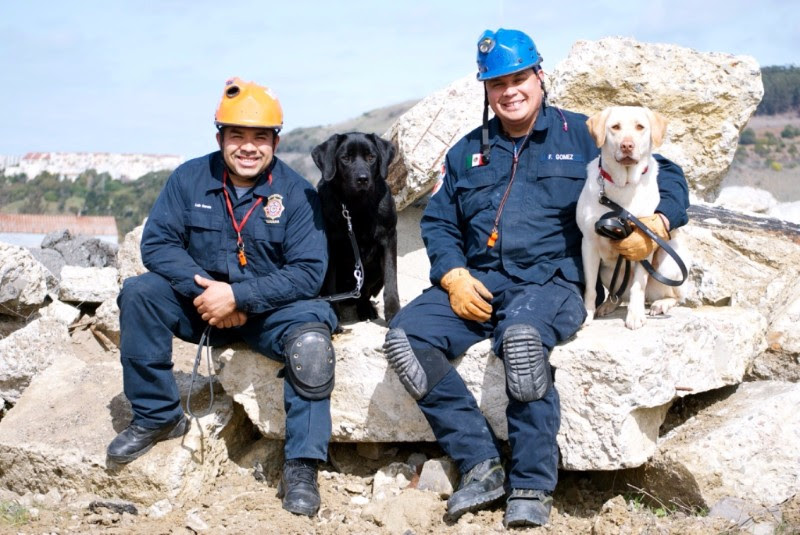
•We don’t usually think of adorable puppies as disease carriers but they might actually be making people sick. The Centers for Disease Control and Prevention is investigating a Campylobacter outbreak in people and its link to puppies purchased from a chain of pet stores.
According to the CDC, at least 39 people across seven states have confirmed or suspected cases of Campylobacter bacteria, which can cause diarrhea, abdominal pain and fever. While the investigation is ongoing, federal officials have linked it to contact with puppies sold by Petland, a chain of pet stores based in Ohio.
Twelve of the confirmed cases are in Petland employees, and 27 other people who fell ill either visited a Petland, recently purchased a puppy there, or visited or live in a home with a Petland puppy. According to the CDC’s announcement, nine people have been hospitalized and there are no reported deaths.
Petland is cooperating with officials in the investigation. In a statement, the company writes, “The CDC has not identified any failures of Petland’s operating system that would lead to any Campylobacter infection.” The company says that accordance with the CDC’s advice, they will continue their efforts to encourage handwashing after contact with puppies.
While the exact cause of this outbreak is not known, there are a few possible reasons the puppies could be sick. Shelley Rankin, an associate professor of microbiology at the University of Pennsylvania’s School of Veterinary Medicine, says that the biggest risk factor is that they’re puppies. Like small children, puppies don’t have a strong immune system and can more easily get sick. Rankin says that she’s seen many outbreak investigations, and it can be difficult to pin down the exact cause.
Vol. 10, No. 25 – Sept 13 – Sept 26, 2017 – The Pet Page
 • A fund raiser for Ventura Police K9 officers’ medical insurance will be held on October 7, 4 to 8pm at the Harbor Cove Café and on the beach. (1867 Spinnaker way at the end). Vendors, raffles, live music ,food and fun for all including the Sunset Glow family fun run, walk, or crawl 5K on the beach. Be sure to visit the Ventura Breeze booth and get a free tennis ball for your dog (or cat).
• A fund raiser for Ventura Police K9 officers’ medical insurance will be held on October 7, 4 to 8pm at the Harbor Cove Café and on the beach. (1867 Spinnaker way at the end). Vendors, raffles, live music ,food and fun for all including the Sunset Glow family fun run, walk, or crawl 5K on the beach. Be sure to visit the Ventura Breeze booth and get a free tennis ball for your dog (or cat).
• The SPAN Thrift Store is providing $10 spays and neuters for low income cat and dog friends.
In the SPAN Thrift Store parking lot 110 N. Olive St. (behind Vons on Main) Friday, September 15th.
Please call to schedule an appointment 584-3823.
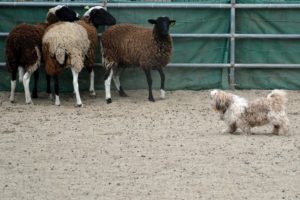
• New research attempts to answer the question whether sleeping with your furry friend(2) is a bad idea for a good night’s sleep.
While some argue that the doggy snoring will ruin their sleep, others love nothing more than a nighttime cuddle with their buddy. However, science may now have resolved the matter, with a new study suggesting that sleeping with your pet can actually help you get a good night’s sleep.
More than 40 million American households have dogs, with 63% of them considering man’s best friend to also be one of the family. However, no matter how much we love our dogs, that doesn’t allow automatic access into the bedroom.
With this in mind, researchers at the Mayo Clinic decided to look into the effect of dogs on sleep quality, recruiting 40 healthy adults without a sleep disorder to take part with their pets.
Both the participants and their dogs were asked (the dogs were asked?)to wear activity trackers to track their sleeping habits for seven nights when they slept in the same bedroom.
The team found that regardless of the size of the dog, sleeping with a furry friend “in the room” helped some people sleep better.
However, having a dog “on the bed” didn’t have the same effect, finding that those who let their canines get too cozy did it at the expense of a good night’s sleep.
“The relationship between people and their pets has changed over time, which is likely why many people in fact do sleep with their pets in the bedroom,” stated Dr. Krahn of the Mayo Clinic. “Today, many pet owners are away from their pets for much of the day, so they want to maximize their time with them when they are home. Having them in the bedroom at night is an easy way to do that. And, now, pet owners can find comfort knowing it won’t negatively impact their sleep.”
• Extracted from article by Cesar Millan:
Intelligent and energetic, Border collies are champion herders — but they aren’t for everyone when it comes to ideal dogs.
All modern Border collies originate from one dog, Old Hemp, who was born in 1893 and sired over 200 offspring. The name comes right from their origins: The border part comes from where they were initially bred in Northumberland, on the border of Scotland and England; the collie part comes from the Celtic word colley, meaning useful or faithful.
Herding dogs originated with the Romans, who brought them to the British Isles, but since the original dogs were from Northern Africa, they couldn’t handle the cold as well. Eventually, invading Vikings bred their dogs with the existing crosses between larger Roman and smaller British dogs. By the 16th century, these cross-breedings had led to various herding dogs, such as the rough collie, Shetland sheepdog, and bearded collie.
They are incredibly intelligent and are often listed among the smartest breeds of dog. They can learn to understand a large number of words, as well as hand gestures and whistles. The downside, of course, is that they can become easily bored or frustrated if they don’t receive proper mental stimulation. More than breed groups, herding dogs need jobs in order to feel fulfilled, which is why things like agility or herding training can be so useful for them.
Because of their skills at learning human words for objects quickly, Border collies have been studied by linguists, who have determined that they have communication skills that even our closest primate relatives don’t. The Border collie Chaser is said to have the largest vocabulary of any non-human animal, at a thousand words.
Border collies are famous for the “crouch” and the “stare” — their ability to move while staying low to the ground, and the intense look they will give to the animals they’re herding in order to control them. And if you have a Border collie, you may have found yourself the subject of the stare at some point, particularly if you were eating.
They’re not just for herding. Border collies can also excel at doing search and rescue work, as therapy dogs, and as… “goose masters,” trained to chase away geese, such as used at the University of Northern Florida.
The breed has been popular with royalty and celebrities over the years.
Vol. 10, No. 24 – Aug 30 – Sept 12, 2017 – The Pet Page
 • Dog friendly downtown restaurants. Between Ventura Ave. and Fir and Poli and Thompson
• Dog friendly downtown restaurants. Between Ventura Ave. and Fir and Poli and Thompson
Winchesters Grill & Saloon
Fluid State
Ventiki Tiki Lounge
SavoryThai Cuisine
Rice
Snapper Jacks Taco Shack
Rumfish Y Vino
Paradise Pantry- tables on sidewalk
Taqueria Vallarta
El Ray Cantina
Capriccio-on sidewalk
Coconut Crab
Grapes & Hops
Busy Bee- tables on sidewalk
Cafe Fiore
Pizza Man Dan
The Tavern
Tonys Pizzeria
Banzai Marina
Barrel House101
The Habit
Sandbox Coffee
Steak & Hoagie
Harvest Cafe
Amigos Cantina
Natures Grill- tables on sidewalk
TAJ- on sidewalk
Jimmy’s Slice- tables on sidewalk
• SPAN Thrift Store is providing $10 spays and neuters for low income cat and dog friends.
In the SPAN Thrift Store parking lot 110 N. Olive St. (behind Vons on Main) Friday, September 15th. Please call to schedule an appointment 584-3823.
Also in the Albert Soliz Library parking lot on August 31.
2820 Jourdan St. Oxnard

• Sept.25 until Oct.1-Bouvier des Flandres Dog Club show at the San Miguel Hall at Seaside Park.
www.SCBDFC.com for more information.
• Well-trained guide dogs are important for visually impaired people who rely on them. But many puppies bred to be guide dogs flunk out of training programs.
A study published in the Proceedings of the National Academy of Sciences suggests the way a puppy’s mother raises it may be the key to the dog’s success, or failure. A research team at the University of Pennsylvania found that puppies destined for guide dog training are more likely to fail if they’re coddled by their mothers.
“Surprisingly, there’s not a lot of research about mothering behavior in dogs,” says lead author Emily Bray.
Past studies on rodents and primates have found that, in general, active mothering is better than no mothering. “So, on one hand, we’d think ‘Yes, you need your mother. Mothering should be a good thing.’ But for guide dogs, the mothers are with their puppies in the pen 24/7. So then the question becomes ‘What exactly is beneficial?’ ”
The answer, at least for guide dogs, appears to be what Bray describes as a hands-off style. (Or, paws-off style?)
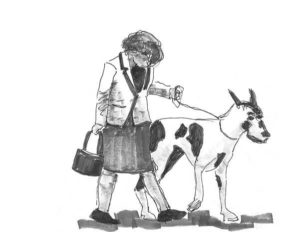
They found that among the 98 puppies they studied, the actively-mothered ones were more likely to fail a guide dog training program later.
How mothers nurse their puppies also affected how puppies performed. The mothers will either lie down to nurse, or sit or stand up. If the mother dog is sitting or standing, “she’s further from the puppy.
The training for guide dogs teaches and selects for a very specific set of skills. “You’re looking for dogs that are very compliant, very, very relaxed, not at all thrown off by any kind of strange occurrences,” says Clive Wynne, a professor of psychology at Arizona State .
The dogs also need to be “sufficiently driven to learn and tackle tasks,” says Bray, and capable of limited disobedience in order to, for example, disobey a command that would put their handler in danger.
Bray thinks that one reason hands-off mothering is associated with more of these traits could be that the little challenges in puppyhood prepare them for the bigger challenges of being a guide dog.
Another possibility is that maternal stress could affect puppy development. Previous research has found higher levels of the stress-related hormone cortisol in dogs with more active parenting behaviors.
Still another possibility is that specific mothering behaviors may not be the primary cause of the observations. It may be more about genetics. The authors point out that high-performing guide dogs are chosen to breed.
Wynne, who was not involved with the research, thinks the findings shouldn’t be applied broadly, even to other working dogs. “I think what we have here is a special effect of working with guide dog populations, and not necessarily true of all dogs or all animals,” he says. Two previous studies on military working dogs and other dogs have found the opposite effect: that more anxious mothers produce more successful offspring in those contexts.
He thinks research like this might help increase the effectiveness and efficiency of training. “So, it’s very powerful and useful,” he says.
Copyright 2017 NPR. To see more, visit http://www.npr.org/.
• How can pet dogs exercise their sense of smell? “Take a smell walk with them.” Dr. Horowitz said. “Let them lead the way and smell and linger. Let them sniff each other. There’s a pleasure for owners in letting a dog be a dog, to acknowledge their dogness. They put up with a lot of our humanness.”
